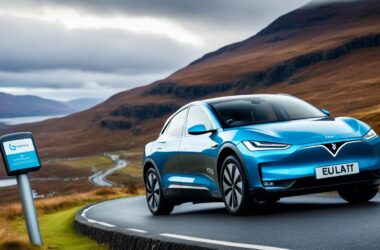When it comes to electric cars, one common question is whether they are all automatic or if there are manual transmission options. The answer is that all electric cars are automatic, meaning they do not have a traditional gearbox like petrol or diesel cars. Instead, electric cars use a single-speed reduction gear or, in some cases, a two-speed gearbox. This allows for seamless acceleration and eliminates the need for manual gear changes.
Electric cars offer a simplified and efficient driving experience with their automatic transmissions. Let’s dive deeper into how these transmissions work and the benefits they provide.
Key Takeaways:
- All electric cars are automatic and do not have traditional gearboxes.
- Electric cars use a single-speed reduction gear or a two-speed gearbox.
- Automatic electric cars provide seamless acceleration and eliminate the need for manual gear changes.
- They offer a simpler driving experience and lower maintenance costs compared to traditional cars.
- Experimental electric car models with electronic “gearboxes” have been developed to enhance driver engagement.
How do Electric Cars’ Transmissions Work?
Unlike traditional cars with manual or automatic transmissions, electric cars have a simplified transmission system. Most electric cars have a single-speed reduction gear that connects the electric motor to the driven wheels. The amount of **electricity** sent to the motor determines how fast the motor turns and, in turn, how fast the car travels. Some high-performance electric cars, like the Porsche Taycan and Audi RS e-tron GT, have a two-speed reduction gearbox to optimize efficiency at high speeds. However, these are exceptions and most electric cars operate with a single-speed transmission.
Electric vehicles (EVs) typically use one of two transmission types to transfer power from the electric motor to the wheels: single-speed transmissions or two-speed transmissions.
In electric cars with **single-speed transmissions**, power is sent from the electric motor directly to the wheels through a single gear ratio. This means there is no need for gears or a clutch, providing a simple and efficient driving experience.
Some high-performance electric cars, such as the Porsche Taycan and Audi RS e-tron GT, are equipped with **two-speed transmissions**. These transmissions allow for optimized performance at different speeds. The first gear provides quick acceleration, while the second gear maximizes efficiency at higher speeds.
Overall, the transmission system in electric cars is designed to provide smooth and seamless power delivery, allowing for efficient and enjoyable driving experiences.
“Electric cars have a simplified transmission system, with most using a single-speed reduction gear or a two-speed gearbox.” – Electric Vehicle Magazine
The Benefits of Automatic Electric Cars
Automatic electric cars offer several advantages over traditional petrol or diesel cars. First, they have less mechanical complexity, as there are no clutches or transmission fluid to change. This translates to lower maintenance costs for owners. Additionally, driving an automatic electric car is more relaxing and smooth, as there are no gear changes to interrupt the power delivery. This seamless acceleration and lack of gear shifting make for a more enjoyable driving experience.
The Advantages of Automatic Electric Cars:
- Easier Maintenance: Automatic electric cars do not have clutches or transmission fluid to maintain or replace, leading to lower maintenance costs over time.
- Relaxing and Smooth Driving: Electric cars with automatic transmissions offer seamless acceleration without the need for gear changes. This provides a more relaxing, uninterrupted driving experience.
- Effortless Power Delivery: With automatic electric cars, there’s no need to worry about shifting gears manually. Power is delivered to the wheels smoothly and instantly, improving overall efficiency and performance.
Overall, automatic electric cars provide a range of benefits that enhance the driving experience while reducing maintenance requirements. Their simplified transmission systems and seamless acceleration make them a popular choice for those seeking a hassle-free and enjoyable electric vehicle.
| Advantages of Automatic Electric Cars | Traditional Cars |
|---|---|
| Easier maintenance with no clutches or transmission fluid | Regular maintenance required for clutches and transmission fluid changes |
| Relaxing and smooth driving experience without gear changes | Manual gear changes can be cumbersome and interrupt power delivery |
| Efficient and instant power delivery | Power delivery depends on gear changes |
Can Electric Cars Be Manual?
While electric cars are primarily automatic, there have been some experimental models that feature manual “gearboxes.” However, these gearboxes are often entirely electronic and serve to enhance the driving experience rather than being necessary for the car’s operation. For example, Lexus has developed an electric car with a manual-style gearbox that controls how the motor’s power is delivered and enhances driver engagement. In general, though, manual transmissions are not common in electric cars.
Enhancing the Driving Experience
In the pursuit of innovation and driver engagement, some automakers have explored the integration of manual-style gearboxes in their electric cars. These gearboxes are not traditional mechanical components, but rather electronic systems that simulate the feel and control of a manual gear shift. By incorporating this feature, automakers aim to provide enthusiasts with a sense of connection and involvement that is reminiscent of driving a manual transmission car.
Electric cars with manual-style gearboxes offer a unique driving experience that combines the instant torque of an electric motor with the thrill of manual gear changes.
One example of an electric car with a manual-style gearbox is the Lexus UX 300e. This compact SUV features an electronically controlled transmission that allows the driver to select different gear ratios, simulating the experience of driving a manual car. By choosing a higher gear ratio, the driver can increase the level of regenerative braking, enabling greater control and a more engaging driving experience.
The Future of Manual Transmissions in Electric Cars
While manual transmissions are not common in electric cars currently, advancements in technology and changing consumer preferences may influence the future of electric car transmissions. As the demand for electric vehicles grows, automakers may explore different transmission options to cater to a wider range of drivers.
However, it’s important to note that the primary advantages of electric cars lie in their simplicity and seamless acceleration made possible by automatic transmissions. The lack of manual gear changes contributes to the overall smoothness and efficiency of electric vehicles.
As the electric vehicle industry continues to evolve, it will be intriguing to see how automakers strike a balance between offering manual-style gearboxes for enthusiasts while prioritizing the benefits of automatic transmissions in electric cars.

While manual transmissions in electric cars remain a rarity, the future holds exciting possibilities for the integration of different transmission systems. Whether it’s enhancing driver engagement or exploring alternative ways to optimize power delivery, the industry’s continuous innovation promises a fascinating evolution in electric car transmissions.
How to Drive an Electric Car
Driving an electric car is similar to driving a petrol or diesel car with an automatic transmission. Simply put the car in “Drive” to go forward, “Reverse” to go back, and “Park” to park.
One aspect of driving an electric car that may be unfamiliar to drivers of traditional cars is regenerative braking. When you lift your foot off the accelerator in an electric car, the car slows down and converts the energy into electricity to recharge the batteries. This can be adjusted in most electric cars to suit the driver’s preference.
Regenerative Braking: What You Need to Know
“Regenerative braking is a key feature in electric cars, allowing the vehicle to reclaim energy that would otherwise be lost as heat during traditional braking. It not only extends the car’s range but also reduces wear and tear on traditional brake components. As you lift your foot off the accelerator, the car switches to regenerative braking mode, utilizing the electric motor as a generator to recharge the batteries. The level of regenerative braking can often be adjusted using the paddle shifters or settings in the car’s interface.”
Whether you’re driving on city streets or cruising on the highway, the driving experience in an electric car is smooth and responsive. The instant torque provided by the electric drivetrain ensures quick acceleration, while the absence of gear changes eliminates any interruptions in power delivery.
So, the process of driving an electric car is straightforward and, in many ways, similar to driving a conventional automatic car. However, the added benefits of regenerative braking and seamless power delivery make electric driving a unique and enjoyable experience.
Now, let’s take a closer look at a comparison between an electric car drivetrain and a traditional internal combustion engine drivetrain:
| Electric Car Drivetrain | Internal Combustion Engine Drivetrain |
|---|---|
| No gears or gear shifting | Multiple gears with gear shifting |
| Instant torque for quick acceleration | Lower torque, gradual acceleration |
| Regenerative braking for energy recapture | Traditional disc or drum brakes for stopping |
| Quieter and smoother operation | Engine noise and vibration |
| Lower maintenance requirements | Regular oil changes, filter replacements, etc. |
As you can see, the electric car drivetrain offers several advantages over the traditional internal combustion engine drivetrain, including simplified operation, instant torque, regenerative braking, and lower maintenance requirements. These factors contribute to the increasing popularity and appeal of electric cars.
Can You Drive an Electric Car with an Automatic License?
It’s common for people to wonder if they can drive an electric car with an automatic license. The good news is, yes, you can! Whether you have an automatic or manual driving license, you are legally allowed to drive an electric car. Electric cars are classified as automatic vehicles due to their unique transmission system.
However, there is an important consideration to keep in mind. If you pass your driving test in an automatic car, which can include electric cars, your license will restrict you to driving automatic vehicles only unless you retake your test in a manual car. This means that if you want the flexibility of driving both manual and automatic cars, you will need to retake your driving test in a manual car to obtain a manual driving license.
Retaking your test in a manual car may seem like an extra step, but it can provide you with more options when it comes to choosing a car in the future. Whether you prefer the ease and convenience of an automatic electric car or the control and engagement of a manual transmission, having a manual driving license gives you the freedom to make that choice.
Driving an Electric Car: Automatic vs Manual Considerations
Driving an electric car with an automatic license offers many advantages. Automatic electric cars are known for their seamless acceleration, smooth driving experience, and simplified operation. There are no gear changes to worry about, making the driving process more relaxing and enjoyable.
On the other hand, driving a car with a manual transmission, whether it’s electric or gasoline-powered, provides a different experience. With a manual transmission, you have more control over the gears and can actively engage with the driving process. Some drivers prefer the tactile feedback and sense of connection that comes with shifting gears manually.
Ultimately, the choice between an automatic and manual electric car depends on your personal preferences and driving style. If you appreciate the convenience and ease of an automatic transmission, an electric car with an automatic license is a great option. If you crave the engagement and control of a manual transmission, consider retaking your driving test in a manual car to obtain a manual license.

| Automatic Electric Cars | Manual Electric Cars |
|---|---|
| Simple and easy to drive | More engaging and tactile driving experience |
| Smooth acceleration and seamless power delivery | Opportunity for optimal gear control and engagement |
| No need to worry about gear changes | Ability to take full control over gear selection |
| Lower maintenance due to simplified transmission system | Requires the skill of shifting gears manually |
Advantages of Automatic Electric Cars
Automatic electric cars offer several advantages over their manual counterparts. They are easier to drive, especially for new or less experienced drivers, as they remove the need for clutch control and gear shifting. With automatic electric cars, drivers can focus more on the road and less on managing the transmission.
One of the significant benefits of automatic electric cars is their lower maintenance costs. Unlike traditional cars with complex transmissions that require regular maintenance, automatic electric cars have simplified transmission systems. This means fewer components to maintain or repair, resulting in potential savings for the owners.
Another advantage of automatic electric cars is their ability to deliver instant power and efficiency. Manual transmissions require gear changes to transfer power from the engine to the wheels, which can interrupt the power delivery. In contrast, automatic electric cars have a direct and continuous flow of power from the electric motor to the wheels. This seamless acceleration improves overall performance and ensures a smoother driving experience.
Comparison of Maintenance Costs: Automatic vs. Manual Electric Cars
| Costs | Automatic Electric Cars | Manual Electric Cars |
|---|---|---|
| Maintenance | Lower maintenance costs due to simplified transmission systems. | Similar to automatic electric cars, but potential additional costs for manual transmission components. |
| Clutch Replacement | N/A | Not applicable as manual transmissions are not common in electric cars. |
| Transmission Fluid | N/A | Not applicable as manual transmissions are not common in electric cars. |
As shown in the comparison table, automatic electric cars generally have lower maintenance costs compared to manual electric cars due to their simplified transmission systems. This can provide a considerable advantage to owners, making automatic electric cars more cost-effective in the long run.
“Automatic electric cars offer simplified operation and lower maintenance costs, making them an attractive choice for drivers of all levels of experience.”
An additional benefit of automatic electric cars is that they are more accessible to a broader range of drivers. Some individuals may have physical limitations or disabilities that make it difficult to operate a manual transmission. Automatic electric cars eliminate these barriers, allowing more people to experience the convenience and benefits of electric vehicles.
In summary, automatic electric cars provide numerous advantages over manual electric cars, including easier driving, lower maintenance costs, and seamless power delivery. With their simplified transmission systems and instant acceleration, automatic electric cars offer an enjoyable and efficient driving experience for all.
The Future of Electric Car Transmissions
Currently, all electric cars are predominantly automatic, utilizing advanced transmission systems to optimize performance and efficiency. However, with the rapid advancements in electric vehicle technology, the future of electric car transmissions holds exciting possibilities.
One area of development in electric car transmissions is the integration of gearboxes to enhance power delivery and performance. Electric racing cars, such as the Formula E vehicles, have already started incorporating gearboxes to optimize their acceleration and top speed capabilities. These gearboxes allow for precise gear ratio adjustments, ensuring optimal power transfer from the electric motor to the wheels.
Furthermore, there have been patent submissions for simulated manual gearboxes in electric cars, hinting at a potential future for electric vehicles with manual transmission options. These simulated manual gearboxes aim to provide a more engaging driving experience, allowing drivers to select different gears to control power output and match their personal preferences.
As technology continues to advance, the future of electric car transmissions is an area of great interest and anticipation. With the growing popularity of electric vehicles, manufacturers and engineers are constantly exploring innovative transmission systems to enhance performance, efficiency, and driver engagement.
The incorporation of advanced transmission technologies in electric cars opens new possibilities for customization and performance optimization. Electric car enthusiasts can look forward to a future where they can tailor their driving experience by selecting different transmission modes or adjusting gear ratios to suit their specific needs and driving style.
Advantages of Future Electric Car Transmissions
The future of electric car transmissions not only brings excitement but also promises several advantages for drivers and vehicle manufacturers:
- Enhanced Performance: By utilizing advanced transmission systems, electric cars can achieve improved acceleration, top speed, and overall performance.
- Efficiency Optimization: Future transmission technologies can further enhance energy efficiency, allowing electric cars to travel longer distances on a single charge.
- Customization Options: With the integration of manual transmission options, drivers will have more control over power delivery and a more engaging driving experience.
- Compatibility with Different Driving Conditions: Advanced transmission systems can adapt to various driving conditions, ensuring optimal performance in city traffic, highways, or off-road environments.
- Reduced Maintenance: Electric car transmissions are inherently simpler and have fewer moving parts compared to traditional internal combustion engines. This results in less maintenance and lower ownership costs.
As electric vehicle technology continues to evolve and mature, it’s essential to stay updated on the latest advancements in electric car transmissions. These developments will shape the future of electric vehicles, providing drivers with enhanced performance, efficiency, and a more personalized driving experience.
| Advantages of Future Electric Car Transmissions |
|---|
| Enhanced Performance |
| Efficiency Optimization |
| Customization Options |
| Compatibility with Different Driving Conditions |
| Reduced Maintenance |
Conclusion
In conclusion, all electric cars are indeed automatic. They do not have traditional gearboxes like petrol or diesel cars but instead utilize single or two-speed transmissions. These automatic electric cars offer numerous benefits, including simplified operation, lower maintenance costs, and seamless acceleration. While manual electric cars are not common, there are some experimental models that feature electronic “gearboxes.”
As the electric vehicle industry continues to advance, we may see further developments in transmission options. Manufacturers and innovators are continuously pushing the boundaries of electric car technology, exploring new ways to optimize power delivery and enhance the driving experience. The future holds exciting possibilities for electric car transmissions.
So, if you’re considering buying an electric car, rest assured that it will be an automatic, providing you with a convenient and enjoyable driving experience. With their seamless acceleration and simplified operation, automatic electric cars offer a glimpse into the future of transportation. Embrace the innovative technology and experience the benefits of electric mobility!











As I web-site possessor I believe the content material here is rattling wonderful , appreciate it for your hard work. You should keep it up forever! Good Luck.
Nice read, I just passed this onto a friend who was doing a little research on that. And he actually bought me lunch since I found it for him smile Therefore let me rephrase that: Thanks for lunch! “He who walks in another’s tracks leaves no footprints.” by Joan Brannon.
Hello. fantastic job. I did not anticipate this. This is a fantastic story. Thanks!
You actually make it seem so easy with your presentation but I find this topic to be really something that I think I would never understand. It seems too complicated and extremely broad for me. I am looking forward for your next post, I’ll try to get the hang of it!
Really Appreciate this update, is there any way I can get an update sent in an email when you make a new post?
You can certainly see your enthusiasm within the paintings you write. The arena hopes for more passionate writers such as you who are not afraid to say how they believe. All the time follow your heart.
My brother recommended I might like this website. He was entirely right. This post actually made my day. You can not imagine just how much time I had spent for this information! Thanks!
I will immediately take hold of your rss as I can not in finding your e-mail subscription link or e-newsletter service. Do you have any? Please permit me recognise in order that I may subscribe. Thanks.
Absolutely pent content, Really enjoyed reading through.